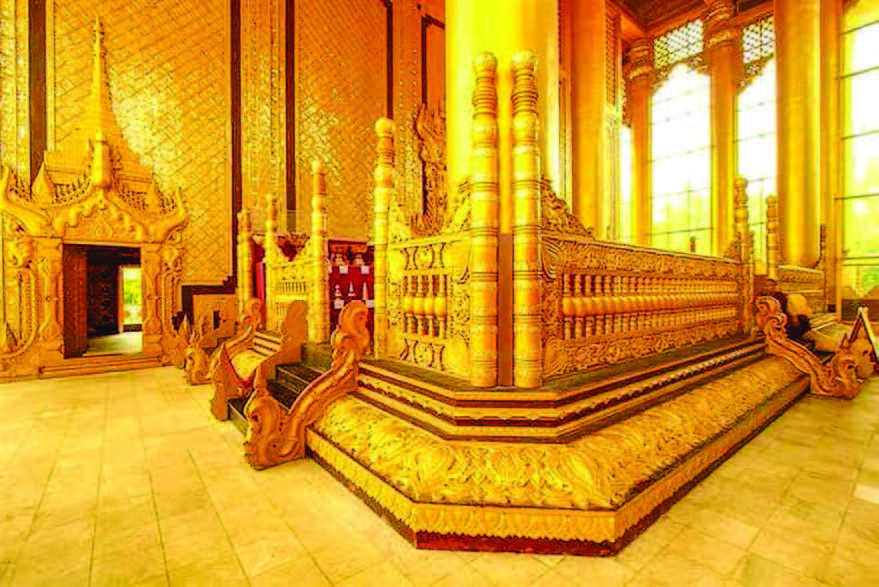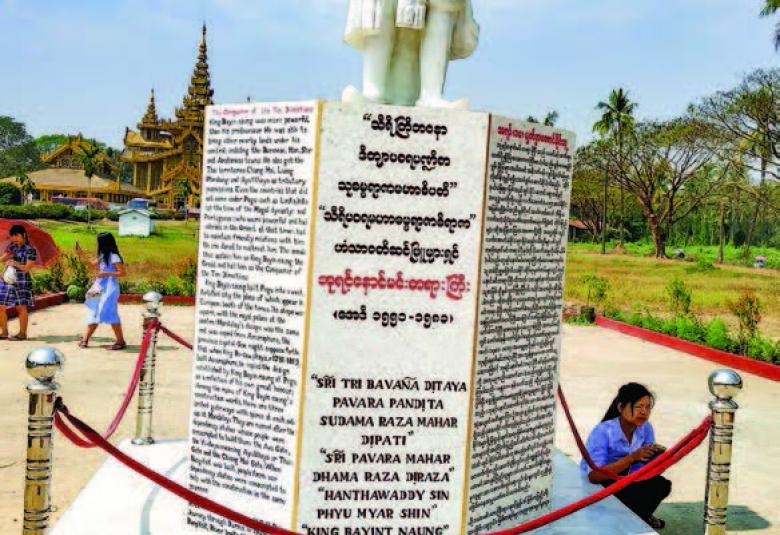TRAVELLERS at home and abroad especially Thai citizens who arrive in Bago pay visits to historic pagodas and stupas in Bago as well as Kanbawzathadi Royal Palace built by King Bayintnaung who reunited the disunited parts of Myanmar to establish the Second Myanmar Empire.
Toungoo era in Myanmar history
Four kings—King Mingyi Nyo (1485-1531 AD), King Tabinshwehti (1531-1550 AD), King Bayintnaung (1551-1582 AD) and King Nanda (1582-1600 AD)—ruled the state in Toungoo era.
King Mingyi Nyo founded Ketumati City on 16 October 1510. Tabinshwehti was born on 28 April 1515. He reigned over Ketumati from 25 November 1530 to 1 May 1550. Then, King Bayintnaung became king of Toungoo.
He built Kanbawzat h a d i Pa l a c e i n B a g o and entered the royal palace through Khemadwara Gate to the throne on 13 March 1567.
King Bayintnaung passed away on 30 October 1582. Prince Nanda succeeded to King Bayintnaung. King Nanda was assassinated by Nat Shin Naung on 20 November 1600.
Bago in the history
Bago, 50 miles from Yangon, takes a position between 17° 14’ and 50’ north latitude and between 96° 24’ and 41’ east longitude. Current Bago Township on 1,121.66 square miles of land is sharing border with Waw and Thanatpin townships in the east, Hlegu, Taikkyi and Thayawady townships in the west, Kawa Township in the south and DaikU and Latpadan townships in the north.
Currently, Bago Township comprises Bago, Phayagyi and Indagaw towns, 40 wards and 211 villages from 65 village-tracts. Historic religious buildings including 78 pagodas are located in Bago Township. Kanbawzathadi royal palace in Nandawya Ward of Bago is the most significant, historic building in Bago.
According to the archives in Hanthawady era, the 312 years period was set as the first Hanthawady era in reigns from Thamala and Vimala brothers to King Tissa, the 186 years period as the second Hanthawady era in reigns from King Byinya Oo to King Thushintakayuppi and the 58 years period as the third Hanthawady era in reigns from King Tabinshwehti to King Nanda.
Kanbawzathadi
King Tabinshwehti ruling Ketumati (Toungoo) City moved his royal palace to Bago after defeating Bago in 1539 AD. King Bayintnaung succeeded to King Tabinshwehti in 1551 AD. He assigned Mon Court of Counsellor Byinya Dala to build a new city for establishment of the royal palace.
King Bayintnaung built a new city with 472 tar in length from the east to the west and with 528 tar in width from the south to the north. Each wall of the city was installed five gates, totalling 20. Gates on the eastern wall were named Pyay, Inwa, Toungoo, Linzin and Dala, the western wall Kalay, Mongnai, Nyaungshwe, Thayawady and Hsenwi, the southern wall Zinmei, Ohnbaung, Mohnyin, Mogaung and Dawei and the northern wall Taninthayi, Yodaya, Mottama, Pakhan and Pathein.
King Bayintnaung summoned one person each from houses as of 22 October 1566 to build Hanthawady City. On 16 November, he built Hanthawady, Shwemawdaw and Pitakat Chamber simultaneously. It took five years for construction of the city. On 4 December 1571, Hanthawady City became the royal palace.
Court of counsellors contributed a log of timber each to construction of the royal palace. Town governors constructed buildings for queens and low grade queens. Three-storey Sekkya buildings were constructed for five queens of the king.
The picture of Kanbawzathadi Royal Place drawn by veteran historian Dr. Than Tun comprised six royal halls with double tiers, a royal building with seven tiers and one hall with single tier.
King Bayintnaung passed away on 30 October 1582 and was succeeded by his son Prince Nanda. In his reign, the combined troops of kings from Toungoo and Rakhine attacked Hanthawady in 1598 and set fire to it.
Archaeological excavations
The Department of Archaeology carried out exploration at the place of Kanbawzathadi Royal Palace in early 1990 and started excavation on 25 April 1991. Excavation tasks lasted till 1997 and research tasks till 2001. During the period, remaining parts of brick stakes, burnt teak posts, Buddha images and ancient objects were found.
According to the archaeological observation, brick stakes of some royal buildings might be assumed as the brick lines of the buildings constructed by King Bayintnaung but some structures might be later works. The excavated teak posts bore manuscripts reviewed as those of 16th century AD. These post inscriptions bore court of counsellors’ names such as Naymyo Kyawhtin, Letya Yantathu and Letya Yantameik.
Reconstruction of replica royal palace
Expects gathered designs of stakes for ancient royal palaces, literary evidences and architectural works for rebuilding the royal palace in original style. They visited various historical buildings such as Kalyani Ordination Hall, Shwegugyi and Shwemawdaw. After reviewing historical evidences included in the records of Sayagyi U Maung Maung Tin (MA) and Myanmar handicraft articles of Sayagyi Tampawady U Win Maung, they drew the design which might be the most similar to the original royal palace.
The Public Works under the Ministry of Construction took responsibility for reconstruction of Kanbawzathadi Royal Palace while Myanmar handicraft expert Tampawady U Win Maung led the decoration of Myanmar arts and crafts at the buildings.
Cornerstones were laid on 28 July 1994 for construction of the hall for Bhamarathana Throne and its construction started on 5 August and completed in 1997. The hall was built with 64 concrete posts, each of which was three feet in diameter. The 133 feet high hall with seven tiers was based on the 92 by 92 feet brick structure. Bhamarathana hall was constituted with the rooms for the throne and the royal couch.
The cornerstones were laid for construction of the ground royal tier-roofed building on 19 March 1995. The foundation was 87.5 by 87.5 feet area on which the building was constructed with 40 concrete posts, each of which was three feet in diameter. Four dimensions of the building were flanked by a small building each with five tiers. As such, the building including the seven tiers was 198 feet high.
The ground royal tierroofed building was flanked by a wing hall each with 144 feet in length, 56 feet in width and 40 feet in height. Each hall was built with 52 concrete posts. The 46 feet long, 38 feet wide and 40 feet high Smok Hall was constructed with 16 concrete posts, each of which was 2.5 feet in diameter. Reconstruction of the ground royal building which displays a throne based on lion statues and left and right royal regalia completed in 2002.
Burnt teak posts were displayed in conditions of excavation period at the left and right wing halls.
The halls showcase teak posts bearing manuscripts and teak sawn timber bearing sculptural works, a log-chipped boat unearthed from dredging Oktha Lake, a replica of the coach served by 16 horses, and documentary photos in excavating the place of the royal palace. The Department of Forest calculated the teak posts were 180 years old.
Hanthawady Archaeological Museum
Hanthawady Archaeological Museum is located between 9th and 10th Nandawgon streets in Bago. It started collection of entrance fee from foreigners in October 1996 and local visitors in May 1997.
The museum showcases 345 kinds of ancient objects— ancient heritage objects found from Kanbawzathadi Royal Palace and ancient objects gathered from Bago Region.
The inscription from the bell of King Bayintnaung was hung at the eastern arch of Bagan Shwezigon Pagoda. The inscription said the king conquered Ketumati on 11 January 1551 and Sri Kestra on 30 August 1551. He marched to Hanthawady with naval and army columns on 12 March 1552 and captured it. He accepted the royal consecration on 12 January 1554.
Despite reducing to ashes, Kanbawzathadi Royal Palace rebuilt in original works as much as possible becomes an historical building where local and foreign travellers pay visit whenever they arrive in Bago.
(Translated by Than Tun Aung)
References: New Maha History (Toungoo Dynasty) (Twinthin Taikwun Maha Sithu U Tun Nyo) Myanmar’s Royal Affairs (Than Tun) King Bayintnaung and masterpieces of Kanbawzathadi (Yin Yin Mon, Archaeology)





